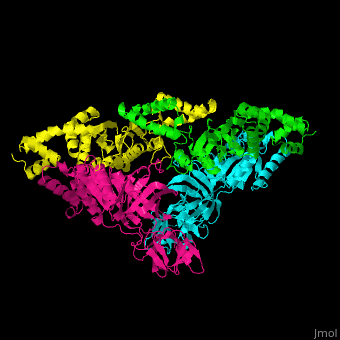Function
Elongation factors (EF) facilitate translational elongation during the formation of peptide bonds in the ribosome.
- EF-selB is selenocysteine-specific EF. See SelB
- EF-Tu or EF 1-α (elongation factor thermo unstable) is a prokaryotic EF. EF-Tu contributes to translational accuracy. It catalyzes the addition of aminoacyl tRNA[1].
- EF-Ts or EF 1-β (elongation factor thermo stable) catalyzes the release of GDP from EF-Tu.
- EF-G translocates the peptidyl tRNA from the A site to the P site while moving the mRNA through the ribosome.
- EF-SII helps RNA polymerase II to bypass blocks to elongation.
- EF-ELL2 enhances polyadenylation and exon skipping with the gene encoding the immunoglobulin heavy-chain complex.
- EF-GreA or GreB are cleavage factors allowing the resumption of elongation.
- EF-NusA recruits translesion DNA polymerases to gaps encountered during translation.
- EF-P alters the ribosome affinity to aminoacyl-tRNA.
- EF-1 γ acts during the delivery of aminoacyl tRNA to the ribosome.
- EF-2 promotes the translocation of the nascent protein chain from the A site to the P site on the ribosome[2].
- EF-3 is a unique EF in fungi hence it provides an anti-fungal drug target. See HEAT Repeat
- EF Spt4, Spt5, Spt6 are conserved among eukaryotes. They modulate the chromatin structure.
- EF-CA150 is believed to play a role in coupling transcription and splicing.
- Elongin complex or SIII activates elongation by RNA polymerase II by suppressing transient pausing of the enzyme[3]. The complex is composed of elongin A, B and C. Elongin A (EloA) is the active component of the complex. Elongin B and C (EloBC) are the regulatory subunits of it. Von Hippel-Landau tumor suppressor protein (VHL) binds to EloBC and inhibits transcriptional elongation.
- Negative EF (NELF) are involved in regulating the pausing of RNA Pol II polymerase transcripton[4].
, or, more exactly (PDB entry 1efu).[5]
3D structures of elongation factor
Elongation factor 3D structures

